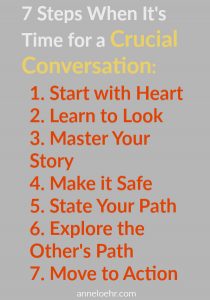 Our relationships and connections with others tend to suffer when we’re feeling anxious. Yet ironically, it’s our relationships and connections that play a key role in our overall well-being.
Our relationships and connections with others tend to suffer when we’re feeling anxious. Yet ironically, it’s our relationships and connections that play a key role in our overall well-being.
Unfortunately, when anxiety escalates, we’re unable to think straight and react in the heat of the moment. Which does not bode well for maintaining close and meaningful relationships with others.
But the good news is we can control our emotions and reactions and keep our relationships strong.
So, how can we get control of anxiety in any given moment and interact with others authentically rather than from an anxious state?
Whenever we feel attacked, personally insulted, threatened, or fearful, our sympathetic nervous system takes over and we experience what’s known as a “fight-flight-freeze” reaction. Simply put, the reasoning part of our brains shuts down and we’re unable to respond rationally in the heat of the moment.
On the other hand, our parasympathetic nervous system, informally referred to as the rest and digest system, inhibits the body from overworking and restores the body to a calm and composed state.
Ideally, both the sympathetic and parasympathetic nervous systems would be in balance. When, however, we experience chronic stress, not uncommon particularly during this global pandemic, the body spends too much time in “fight or flight” mode, and very little in “rest and digest.”
To gain control of anxiety for calmer, more fulfilling connection in your relationships, start by spending more time in “rest and digest” mode. The more we practice activating our rest and digest parasympathetic nervous system, the more we’ll have it when we need it most. Here are 5 things to practice routinely:
- Deep breathing. You might try these out (I’ve found Alternate Nostril Breathing particularly effective);
- Meditation;
- Regular exercise or yoga;
- Screen time breaks. To learn more, check out this article.
- Gently running your finger over your lips (haven’t tried this one yet…)
You can bet I’ll be doing one or more of these daily – these are stressful times – and I invite you to join me!
Like this post? Please share or sign up to subscribe weekly and you’ll never miss a post.
 Divorce can be one of life’s most difficult transitions. If you’re a parent and are recently separated or divorced, here are 3 tips for sharing the kids with your spouse during the holidays.
Divorce can be one of life’s most difficult transitions. If you’re a parent and are recently separated or divorced, here are 3 tips for sharing the kids with your spouse during the holidays. Over the course of the past crazy months of the global pandemic, I found myself resisting – and resenting – what was.
Over the course of the past crazy months of the global pandemic, I found myself resisting – and resenting – what was. You know that feeling when you “click” with someone? It feels like a spark of energy that lifts you up. And that energy builds on itself making for a real connection between you and the other person.
You know that feeling when you “click” with someone? It feels like a spark of energy that lifts you up. And that energy builds on itself making for a real connection between you and the other person. The holiday season can be stressful under normal circumstances. But this year, the pandemic brings additional challenges. How will we spend time with family members and other loved ones this holiday season?
The holiday season can be stressful under normal circumstances. But this year, the pandemic brings additional challenges. How will we spend time with family members and other loved ones this holiday season? Divorcing spouses typically obtain or exchange information about each other’s incomes, assets, and debts acquired during the marriage. This process, called “discovery,” typically includes exchanging documents that include bank and other account statements, credit card statements, and employment records. Accurate values for assets like a home, business, or retirement plan, however, might require outside professionals like appraisers or accountants.
Divorcing spouses typically obtain or exchange information about each other’s incomes, assets, and debts acquired during the marriage. This process, called “discovery,” typically includes exchanging documents that include bank and other account statements, credit card statements, and employment records. Accurate values for assets like a home, business, or retirement plan, however, might require outside professionals like appraisers or accountants. I always knew I wanted to be a lawyer. I just didn’t hadn’t really known why – I simply believed that being a lawyer would give me the financial security I didn’t have as a kid growing up.
I always knew I wanted to be a lawyer. I just didn’t hadn’t really known why – I simply believed that being a lawyer would give me the financial security I didn’t have as a kid growing up.
 When you and your spouse decide to divorce, it can be difficult to remain together in the marital home. Young kids, in particular, can often sense the discord or hostility between you and your spouse. Even if there is no outright shouting or arguing, it’s common for kids to sense coldness or distance between the two of you. Before making the decision to move out of the marital home, here are 4 important things to consider:
When you and your spouse decide to divorce, it can be difficult to remain together in the marital home. Young kids, in particular, can often sense the discord or hostility between you and your spouse. Even if there is no outright shouting or arguing, it’s common for kids to sense coldness or distance between the two of you. Before making the decision to move out of the marital home, here are 4 important things to consider: Do spousal spats or sibling squabbles at home take their toll on you and your family? If so, you’re not alone. Most all families argue, some more than others.
Do spousal spats or sibling squabbles at home take their toll on you and your family? If so, you’re not alone. Most all families argue, some more than others. When we want to sell someone on a position or idea, we often focus our efforts on what we can say to convince the other person.
When we want to sell someone on a position or idea, we often focus our efforts on what we can say to convince the other person. If you’re like many people considering divorce, you might be leery about getting lawyers involved. After all, it’s a common belief that lawyers mean fighting and expensive legal fees.
If you’re like many people considering divorce, you might be leery about getting lawyers involved. After all, it’s a common belief that lawyers mean fighting and expensive legal fees. No doubt about it – divorce is a topsy-turvy crazy emotional time – for kids and parents alike. And trying to be a good parent when you’re at your worst can be overwhelming and exhausting.
No doubt about it – divorce is a topsy-turvy crazy emotional time – for kids and parents alike. And trying to be a good parent when you’re at your worst can be overwhelming and exhausting. Think of a time when a conversation suddenly turns heated. Perhaps a co-worker makes a derogatory comment to you in front of colleagues. Or a close friend neglects to call you on your birthday. Or your spouse nags and criticizes you.
Think of a time when a conversation suddenly turns heated. Perhaps a co-worker makes a derogatory comment to you in front of colleagues. Or a close friend neglects to call you on your birthday. Or your spouse nags and criticizes you. In any relationship, whether at work or home, conflict is inevitable. You might not be surprised that relationship conflict can affect your mental and emotional health. But did you know it can also affect you physically?
In any relationship, whether at work or home, conflict is inevitable. You might not be surprised that relationship conflict can affect your mental and emotional health. But did you know it can also affect you physically? When you’re a separated or divorcing parent, chances are you’re concerned about the kids if you or your spouse were to move out of the home.
When you’re a separated or divorcing parent, chances are you’re concerned about the kids if you or your spouse were to move out of the home. If you’re like many spouses facing divorce, you might believe that marital assets and debts are divided according to which spouse owns a particular asset or incurred certain debts.
If you’re like many spouses facing divorce, you might believe that marital assets and debts are divided according to which spouse owns a particular asset or incurred certain debts. There’s no denying that when we have satisfying intimate personal relationships, we generally experience less stress, greater emotional and physical well-being, and more resiliency to bounce back from adversity.
There’s no denying that when we have satisfying intimate personal relationships, we generally experience less stress, greater emotional and physical well-being, and more resiliency to bounce back from adversity. While we practice social distancing, it’s more important than ever to maintain connection with those closest to us.
While we practice social distancing, it’s more important than ever to maintain connection with those closest to us. You might be able to think of at least one conversation right now that you’ve been putting off. Perhaps you believe that saying something will only make things worse. When it comes to family members, certain conversations can be difficult because they’re so fraught with emotion.
You might be able to think of at least one conversation right now that you’ve been putting off. Perhaps you believe that saying something will only make things worse. When it comes to family members, certain conversations can be difficult because they’re so fraught with emotion.

 If you’re a separated or divorcing parent, one of the first things to do is to determine when and how your kids will spend time with each parent.
If you’re a separated or divorcing parent, one of the first things to do is to determine when and how your kids will spend time with each parent.



 If you have kids and are separated or divorced, this post is for you – especially if you want to stay out of court.
If you have kids and are separated or divorced, this post is for you – especially if you want to stay out of court. You know the feeling. You’re in the middle of a conversation with someone – your spouse, friend, or co-worker – when the person says something that offends you or makes you angry.
You know the feeling. You’re in the middle of a conversation with someone – your spouse, friend, or co-worker – when the person says something that offends you or makes you angry. Divorce in New Jersey just got a bit easier and less costly.
Divorce in New Jersey just got a bit easier and less costly. Divorce is more than a legal process. It is an extremely emotional process. It’s also common for one spouse to want a divorce while the other does not. More often, one of the spouses decides, over a period of time, to end the marriage.
Divorce is more than a legal process. It is an extremely emotional process. It’s also common for one spouse to want a divorce while the other does not. More often, one of the spouses decides, over a period of time, to end the marriage. Whenever we feel attacked or threatened – even if we feel disrespected, insulted, or personally attacked – we experience what’s known as a “fight-flight-freeze” reaction. Simply put, the reasoning part of our brains shuts down and we’re unable to respond rationally in the heat of the moment.
Whenever we feel attacked or threatened – even if we feel disrespected, insulted, or personally attacked – we experience what’s known as a “fight-flight-freeze” reaction. Simply put, the reasoning part of our brains shuts down and we’re unable to respond rationally in the heat of the moment. Do you often find yourself holding in your anger at someone to avoid a conflict? Perhaps you’ve held in your anger for so long that you eventually erupt and lash out at this person.
Do you often find yourself holding in your anger at someone to avoid a conflict? Perhaps you’ve held in your anger for so long that you eventually erupt and lash out at this person.